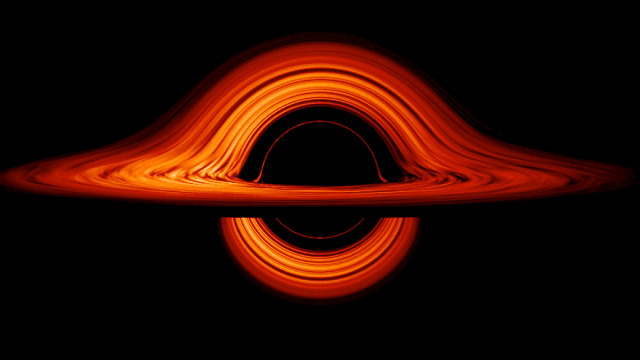NASA Wants You to Know That Black Holes Are Even Crazier When Viewed from the Side
Warning: Objects orbiting black hole may appear closer than they actually are.

Viewed straight-on, a black hole pretty much lives up to its name. It's black. It's a hole. I'm goin' on break.
When a black hole's seen from the side, however, things start to get a little more … twisted. A mesmerizing new simulation created by researchers at NASA's Goddard Space Flight Center (GSFC) shows this effect, with a ring of matter swirling around a black hole's edge, seeming to impossibly bend above, below and around the hole at the same time.
According to a blog post on NASA's website, this double-humped silhouette is a trick of light created by the unfathomably strong gravitational pull of a typical black hole. This force can be so powerful that it pulls the light from different parts of the black hole's surroundings into different directions simultaneously.
"Simulations and movies like these really help us visualize what Einstein meant when he said that gravity warps the fabric of space and time," GSFC researcher Jeremy Schnittman, who created the images, wrote in the blog post.
Schnittman's simulation (which he broke down into about a dozen different GIFs) shows the halo of gas, dust and other matter getting sucked toward a black hole, also known as the hole's accretion disk. In the simulation, that disk changes in appearance depending on the viewer's vantage point.
Seen from a bird's-eye view, the disk looks like a flaming vortex of orange fire swirling around a circle of darkness. (Not so different from the first direct image of a black hole, taken by the Event Horizon Telescope earlier this year.) The closer matter gets to the center of the hole, the faster it swirls, heating up and speeding up to near light speed just outside the event horizon — that "point of no return" beyond which no matter or light can escape.
Looking onto one edge of the disk, meanwhile, the hole's gravity quickly distorts our view. While the nearer side of the disk passes in front of the black hole as you'd expect, the far side gets warped into two mirror-image humps. Light from the top of the disk's far edge arcs over the top of the black hole, while light from the underside of the disk bends underneath the hole. The result is an image that looks more like a fiery silhouette of Saturn than the picture of a black hole we're so used to imagining. But with a quick switching of the camera angle, the accretion disk bends back into the flat vortex we expect.
Get the world’s most fascinating discoveries delivered straight to your inbox.
This is all just a reminder that black holes are really, really cool — no matter how you look at them.
- The 12 Strangest Objects in the Universe
- 15 Unforgettable Images of Stars
- 9 Strange Excuses for Why We Haven't Met Aliens Yet
Originally published on Live Science.



Brandon is the space / physics editor at Live Science. With more than 20 years of editorial experience, his writing has appeared in The Washington Post, Reader's Digest, CBS.com, the Richard Dawkins Foundation website and other outlets. He holds a bachelor's degree in creative writing from the University of Arizona, with minors in journalism and media arts. His interests include black holes, asteroids and comets, and the search for extraterrestrial life.



